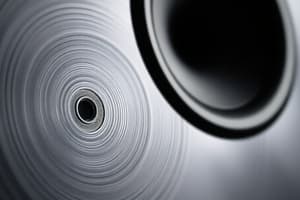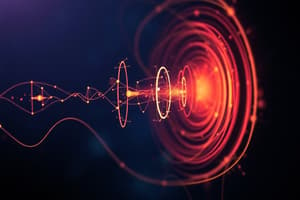Podcast
Questions and Answers
In which way does sound travel through mediums?
In which way does sound travel through mediums?
- As an electrical wave.
- As a solid wave.
- As a mechanical wave. (correct)
- As a thermal wave.
Which statement about sound is correct?
Which statement about sound is correct?
- Sound is a type of electromagnetic wave.
- Sound can travel through a vacuum with no medium.
- Sound is a static wave that does not vary in pressure.
- Sound cannot travel through a vacuum. (correct)
What causes sound waves to be produced?
What causes sound waves to be produced?
- Vibrations of objects that disturb the surrounding medium. (correct)
- The movement of air molecules in a vacuum.
- The perception of sound by the brain.
- Temperature changes in the atmosphere.
Which of the following describes a region of decreased pressure in a sound wave?
Which of the following describes a region of decreased pressure in a sound wave?
Which parameter is NOT used to describe sound waves?
Which parameter is NOT used to describe sound waves?
What is required for sound waves to travel?
What is required for sound waves to travel?
Which of the following parameters describes the height of a sound wave?
Which of the following parameters describes the height of a sound wave?
What occurs during the rarefaction phase of a sound wave?
What occurs during the rarefaction phase of a sound wave?
How does the vibration of an object affect the surrounding air molecules?
How does the vibration of an object affect the surrounding air molecules?
Why is there no sound in outer space?
Why is there no sound in outer space?
What is a key feature of electromagnetic waves in relation to mediums?
What is a key feature of electromagnetic waves in relation to mediums?
Which part of a wave represents the highest point of a disturbance?
Which part of a wave represents the highest point of a disturbance?
What distinguishes sound waves from waves that do not require a medium?
What distinguishes sound waves from waves that do not require a medium?
What is indicated by the term 'trough' in wave terminology?
What is indicated by the term 'trough' in wave terminology?
How does the energy transfer occur in waves?
How does the energy transfer occur in waves?
What is essential for sound to travel through mediums?
What is essential for sound to travel through mediums?
What can indicate the presence of vibrations when sound is produced?
What can indicate the presence of vibrations when sound is produced?
What happens to the sound when the vibrations cease?
What happens to the sound when the vibrations cease?
Why can't humans converse normally on the moon?
Why can't humans converse normally on the moon?
How is sound transmitted through different media?
How is sound transmitted through different media?
What primarily causes the production of sound?
What primarily causes the production of sound?
Which of the following best describes how sound travels?
Which of the following best describes how sound travels?
Which aspect of sound is NOT typically considered a characteristic?
Which aspect of sound is NOT typically considered a characteristic?
What is essential for the propagation of sound waves?
What is essential for the propagation of sound waves?
Which principle involves the bending of sound waves as they pass through different media?
Which principle involves the bending of sound waves as they pass through different media?
What term refers to the time it takes for one complete wave to pass a given point?
What term refers to the time it takes for one complete wave to pass a given point?
Which of the following accurately defines amplitude in the context of waves?
Which of the following accurately defines amplitude in the context of waves?
What is the symbol used to represent wavelength?
What is the symbol used to represent wavelength?
Which of the following best describes frequency?
Which of the following best describes frequency?
In the context of longitudinal waves, what does wavelength measure?
In the context of longitudinal waves, what does wavelength measure?
What phenomenon occurs when the bob of a pendulum traces a point after a regular period of time?
What phenomenon occurs when the bob of a pendulum traces a point after a regular period of time?
Which statement correctly describes the relationship between wavelength and amplitude?
Which statement correctly describes the relationship between wavelength and amplitude?
Which unit is used to measure frequency?
Which unit is used to measure frequency?
What does the crest of a wave represent?
What does the crest of a wave represent?
Which of the following statements best describes a periodic wave?
Which of the following statements best describes a periodic wave?
Flashcards are hidden until you start studying
Study Notes
Sound Production and Characteristics
- Sound is produced by vibrations that travel through a medium.
- Vibrations induce air pressure fluctuations, resulting in sound waves that require a medium to travel.
- Sound cannot propagate in a vacuum; thus, conversation on the moon is not feasible due to sparse air.
- When an object vibrates, it compresses and rarefies surrounding air molecules, creating sound waves that radiate outward.
Nature of Sound
- Sound is classified as a longitudinal mechanical wave.
- It travels faster in solids than in liquids, and slowest in gases.
- Key parameters defining a wave include wavelength, amplitude, frequency, and time period.
- Sound pressure variations create compression (increased pressure) and rarefaction (decreased pressure).
Sound Transmission and Reflection
- Sound waves reflect off surfaces, leading to sound transmission into adjoining spaces.
- Energy from sound waves can be absorbed, transmitted, or reflected by materials.
- Sound Absorption Coefficient (α) indicates a material's ability to absorb sound, ranging from 0 (total reflection) to 1 (total absorption).
Music vs. Noise
- Music is structured and pleasing, characterized by periodicity, while noise is random and often irritating.
- Musicians evaluate sound by quality, pitch, and loudness; distinct sounds can share loudness and pitch but differ in timbre.
- Regular sound pressure variations over time denote musical characteristics, while irregular changes indicate noise.
Understanding Timbre and Harmonics
- Timbre derives from the combination of fundamental frequency, harmonics, and overtones that define a sound's character.
- Harmonics are frequency waves set in motion by an object's vibrations, shaping the sound's overall quality.
- More harmonics introduce complexity and pleasantness to the sound, creating unique auditory experiences.
Loudness
- Loudness corresponds to the intensity of sound, dictated by the amplitude of vibrations.
- Sounds like dynamite explosions are louder than smaller sounds due to greater displacement of air molecules.
- Context is important for perceiving loudness; it becomes meaningful through comparison.
Summary of Key Learnings
- Sound results from vibration, necessitating a medium for travel.
- It is measured by key parameters and classified into music and noise based on characteristics.
- Understanding sound assists in the development of technologies like microphones, speakers, and sound recording devices, enhancing communication efficiency.
Electromagnetic Waves and Sound Waves
- Electromagnetic waves travel through space without needing a medium, allowing communication from distant stars and satellites.
- Waves involve periodic motion and energy transportation, demonstrated by stone disturbances in water.
- Continuous circular disturbances in water highlight crest (raised part) and trough (low part) in a wave, indicating energy transfer without material movement.
Nature of Sound
- Sound is a mechanical wave that requires a medium (solid, liquid, or gas) to travel and cannot exist in a vacuum, like outer space.
- Sound involves pressure variations with two key components: compression (increased pressure) and rarefaction (decreased pressure).
- Sound waves propagate through vibrating objects, causing air molecules to compress and rarefy while maintaining their average position.
Wave Parameters
- Waves are described using parameters such as wavelength, amplitude, frequency, and time period.
- Wavelength is the distance between successive crests, troughs in transverse waves, and compressions, rarefactions in longitudinal waves.
- Longitudinal waves can form in solids, liquids, and gases, illustrated with compressions and rarefactions in springs.
Sound Wave Behavior
- Refraction refers to the bending of waves entering different media; it is less significant in sound compared to light.
- Reflection follows the law of reflection: angle of incidence equals angle of reflection, similar to light and other waves.
- Reflected sound can interfere with incident waves, creating resonances and standing waves, which enhance sound intensity near hard surfaces.
Sound Energy Transfer
- Sound transmission occurs when waves touch surfaces, creating reflective waves while transmitting some energy through walls.
- Sound absorption involves energy being converted to heat upon striking surfaces, influenced by material properties and expressed through the sound absorption coefficient (α).
Music vs. Noise
- Music consists of harmonious sounds with periodicity, while noise is irregular and often unpleasant to hear.
- Telecommunications convert sound waves into electromagnetic waves for transmission and reconversion back into sound waves at the receiver.
Components of Sound
- Key elements influencing sound perception include pitch, timbre, harmonics, loudness, rhythm, and sound envelope components: attack, decay, sustain, release, and speed.
Questions to Consider
- Discuss elements that define sound.
- Explore reasons for the inability to hear on the Moon.
- Describe experiments demonstrating sound vibrations.
- Explain the relationship among sound velocity, wavelength, and frequency.
- Identify differences between longitudinal and transverse sound waves.
- Analyze the speed of sound in solids versus air.
- Distinguish between noise and music.
- Elaborate on sound characteristics.
- Describe the process of sound transmission.
- Explain sound absorption in various materials.
Overview of Sound
- Sound consists of vibrations produced by a source, which travel through a medium as waves.
- Different types of sounds range from conversations to environmental noises like bird chirping and vehicle horns.
- Sound waves differ from electromagnetic waves, such as radio waves, used in communication technologies.
Key Concepts in Sound
- Sound is defined as the mechanical wave resulting from vibrations, detected by the ear drum.
- A medium, such as air, is essential for sound to propagate; sound cannot travel through a vacuum.
- Sound travels mechanically, and its characteristics can be observed through experiments with vibrating objects.
Properties of Waves
- Amplitude measures the height of the wave from its equilibrium position, affecting the loudness of sound.
- Wavelength (λ) is the distance between adjacent crests or troughs of a wave, measured in meters.
- Frequency (n) quantifies how many complete waves pass a point per second, measured in Hertz (Hz).
- Time Period (T) is the time taken for one complete wave cycle, indicated in seconds.
Sound Transmission
- As sound waves travel and encounter surfaces, some energy is reflected, while some may transmit into other spaces.
- Sound transmission efficiency varies based on the material properties of surfaces encountered.
Sound Absorption
- When sound waves meet a surface, some energy is absorbed and converted to heat; this reduces the sound intensity.
- The sound absorption coefficient (α) indicates a material's absorption effectiveness, with values varying from 0 (no absorption) to 1.0 (complete absorption).
Difference Between Music and Noise
- Music is organized and harmonious, whereas noise is random and often considered unpleasant.
- Music usually has structure, rhythm, and periodicity, while noise lacks these characteristics.
Sound Decay and Sustain
- Decay refers to the gradual reduction in sound amplitude after a sound source stops vibrating.
- Sustain defines the duration a sound can maintain its peak intensity before it begins to fade.
Envelope of Sound
- The envelope describes sound dynamics through four stages: Attack, Decay, Sustain, and Release (ADSR).
- Attack is the initial onset of sound, Decay is the reduction post-attack, Sustain is the period of steady sound, and Release is the final fade.
Influence of Speed on Sound
- Playback speed changes can drastically alter sound characteristics; doubling the speed raises pitch and changes perception.
- Standard film playback speeds impact how sound and visual media interact, affecting smoothness and audio frequency.
Studying That Suits You
Use AI to generate personalized quizzes and flashcards to suit your learning preferences.




